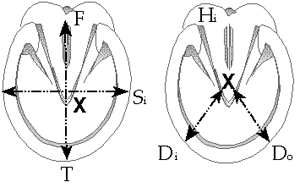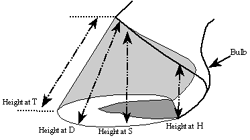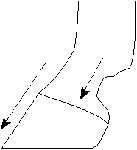 EVALUATING HOOF BALANCE – Page 2 You will need chalk or marker, a protractor, a small ruler or measuring tape, and pencil and paper. Note all measurements as you go along, and be accurate to 1/16 inch (or 1 mm). Having someone write down the measurements as you call them out facilitates the procedure. Measuring the base
of the foot:
2) Measure the width of the foot from edge to edge (S-inside to S-outside), through X. If the horse is shod, measure to the outside edge of the shoe. Note also whether the measurements on each side of X are equal. 3) With the baseline of your protractor centered at X and lined up with the center of the toe (T), mark the two 45Ð points (D-inside and D-outside) at each side of T on the bottom of the foot and on the wall. 4) Measure from the inside 45Ð mark (Di) to X to get the Inside Toe Diagonal measurement, and from the outside 45Ð mark (Do) to X for the Outside Toe Diagonal. Measuring the hoof
walls 5) Measure at centre toe (T) on the wall, from the bottom of the hoof or shoe to the hairline, to give the centre toe height.
6) Measure the wall at the inside 45Ð, Di, for inside toe height, and at Do for the outside toe height. Follow the hoof tubules. 7) Measure the wall vertically at So and Si for height at sides (quarters). 8) The height of the heel should be measured vertically from where the heel of the hoof actually bears weight at the back of the foot. Measure both heel heights on each hoof.
The Balanced Foot • Base length (ground surface) of one foot must equal its pair, eg both forefeet should be the same length. In a shod horse, length of shoes should be equal, of course, but the actual foot bases should also match if possible. (With uneven base lengths within a pair, toe of longer foot will need to be rasped back so base lengths are as close to equal as possible.) If toe has been rasped back, make sure hoof wall from coronet to ground surface is straight (no bulges in the hoof wall). • The base width will not be greater than the base length. • The centerline of the frog should correspond to the centerline of the foot and shoe, with—ideally— the same width on each side of the center of the frog. Make sure you follow the corium of the frog (the deep. live frog), as the horny frog may deviate at the ground surface. • Shoes should be as rounded as possible in the front part of the hoof, i.e. no corners or straight sections, not even slight ones. No squared toes. • Although the hind feet should be more oval than the forefeet, relatively pointed toes on the hinds are more appropriate for driving horses than riding horses. • With rockered toes, the rocker should be minimal, with just enough space to insert a credit card or two between the toe and the ground. • Where possible, heels of the shoe should extend back to support the widest part of the frog, where the frog comes off the ground, but must not curl over the frog. • If barefoot, the wall’s ground surface should extend to the widest part of the frog. • Heels of the shoe may extend further to support the bulbs, and should do so when used with wedge pads. • The centre toe height should be equal to the side toe heights at D. • The slope of the front wall of the hoof should match the slope of the back of the pastern when the horse is standing straight over the leg. Although traditionally the front of the pastern is used as a gauge, it can give a ‘false’ reading.
• The support heel of the foot will be located under the column of the leg (no underrun heels), but if not the toe should be taken back as much as possible and the shoes must extend beyond a plumb line dropped from the front of the cannon.
Ideal base
measurements: • Base length will not be less than base width • 1/2 base length = inside toe diagonal =outside toe diagonal
Ideal hoof wall
measurements: • Inside toe height (at Di) = outside toe height (at Do) = centre toe height (at T) • Back of pastern angle = front hoof wall angle • Actual, numeric angles should only be used as a guide. Each horse’s angles are different.
The Shoes: • Shoe will extend to widest point of frog and if necessary a little beyond, to support the bulb and column of leg. • Centre of toe (of shoe) should be in line with centerline of frog. Toe flare stresses the pastern and forces the pastern in the opposite direction, eg outside toe flare pushes the pastern to the inside. Excess wall length at the toe will stress the knee, forcing it in the opposite direction, eg. a long point at the outside toe pushes the knee to the inside. Excess wall length can frequently “hide” in the coronary band where the coronary band has a rise in it, even though the ground surface of the hoof appears level. Frequently, after the hoof is otherwise balanced, if the horse is allowed to stand for some minutes, or walked around, the wall releases to a greater or lesser extent, although longstanding imbalances may take days to release. Accurate measuring can help you see this. More subtle, non-visible long points can also be located by running your finger around the pastern about a quarter inch above the coronary band. You will frequently feel “lumps” (sometimes mistaken for arthritic changes such as sidebone) where the hoof wall is hiding. Follow the tubules down to the ground surface to find the location of the long points and rasp there. People think I've really lost it when I tell them this, and they are shocked when they witness it for themselves!
Now that you've measured your horse’s feet, you may have found that your horse is not balanced. If so, you may also find that your farrier is less interested in making the changes than you are. Don't be put off. This precision shoeing is already being more readily accepted than it was when I first got into it, and your horse's comfort may depend on it. If you feel like boggling your mind, draw four horseshoes on a piece of paper, representing your horse’s feet. Working with hoof pairs, eg. the forefeet, try to calculate the size of the long points and flares and mark them in the appropriate places, and establish a minimum reference measurement, e.g. if one base length is shorter, use that shorter one to calculate the overall excess in base length of the other foot. It can get complex, but it's an enlightening exercise! If you succeed, you will see that diagonal feet tend to have the same imbalances, i.e. toe flare on the inside (right side) of the left fore is often matched by toe flare on the outside (right side) of the right hind… Is there a connection? You bet! ¶ Return to Riding Theory
Main Page Return to Hoof Balance
Intro Article
Email : rafalet2ride@yahoo.ca | Home | Lusitanos | Equine
Biomechanics & Riding Theory | Last updated December 28, 1999 All rights reserved |


